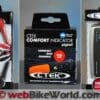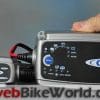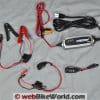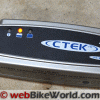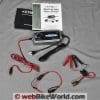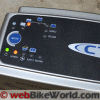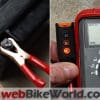Bigger isn’t necessarily better.
The CTEK 800 works just fine as a motorcycle battery charger, even though it’s the entry-level unit.
And there’s a bonus: it’s cheaper and less complicated.
Nothing wrong with the CTEK 7002, mind you, but do you really need 8 steps and up to 150Ah charging capacity when 4 steps and 32Ah will do just fine?
Our conclusion is that for basic motorcycle battery maintenance and occasional charging, the CTEK 800 is a good choice.
Motorcycle battery chargers are among the most difficult products to review.
There is a lot of marketing hype and not a lot of knowledge to sort it out.
Connect a charger, plug it in and it works. Does anyone really care if there are 4, 6, 8 or more charging steps? Or one?
As long as a green light comes on at some point, you’re golden.
But with dozens of different battery chargers available — each one claiming to be “smarter” than the other — how do you choose?
We’ve come to the conclusion that for general motorcycle battery charging and maintenance, a charger can now be considered as a commodity item; that is, one is just about as good as another.
The manufacturers will blanch when they hear this, but honestly, there just isn’t much of a discernable difference between any of them.
Our advice is to buy one that fits your budget and don’t get hypnotized by all the fancy features you most likely do not need and will never use. And buy from a name-brand manufacturer. Simple, eh?
One of the big reasons behind this thinking is the hard, cold fact that there are three Battery Tenders that have been running in the webBikeWorld garage non-stop, 24 hours a day, 7 days a week, 365 days a year since 1999.
They do the job, day after day, year after year without a bit of maintenance, worry or care. What more could one ask for?
They don’t have any “steps”, “modes” or “pulses”. There are two lights: red, which means bad and green for good.
They also serve as the baseline for comparing any new motorcycle battery chargers we review. If they’ve been working this well for all these years, why do we need anything different?
Back in 1999, Battery Tender brand was about the only game in town. They’re now so ubiquitous that the term “Battery Tender” has become synonymous with “battery charger”, much to the dismay of the Battery Tender folks I’m sure.
Every motorcycle that comes in the door here immediately gets an SAE harness attached directly to its battery and then it gets connected to a Battery Tender.
The bikes remain on the Battery Tender whenever they are not on the road. As soon as the bike comes back in from a ride, it gets connected to a Battery Tender.
The only exception is the Suzuki DR650 (blog), which is undergoing a long-term reliability evaluation for the Shorai battery (review) we installed last winter. So far, the Shorai Lithium-Iron-Phosphate (LFP) type battery is amazing.
It maintains an almost unreal level of charge at all times and seems to spring back to full voltage almost instantly after the engine is started. The Shorai simply has not needed any type of charging, no matter how badly we use and abuse it.
Battery charger manufacturers probably lie awake at night, thinking of what will happen when the use of LFP batteries becomes commonplace.
So if you really want a maintenance-free battery (that weighs ounces, not pounds) that requires minimal reliance on a battery charger, spend the money and get an LFP. So far, our experience has been outstanding and well worth the initial outlay.
In the meantime, a battery charger and battery charge maintenance device is a crucial tool for the garage.
By the way, CTEK confirmed that their chargers do not work with LFP batteries. So much for a “smart” charger…
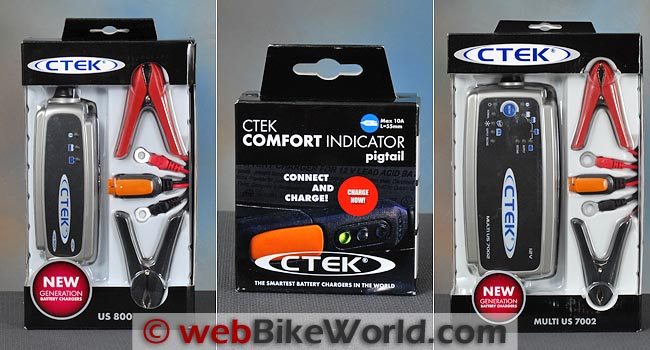
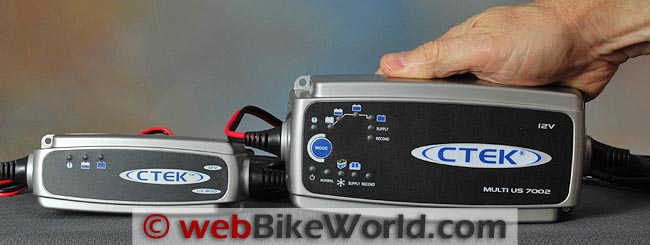
CTEK Battery Chargers
CTEK is a Swedish company, started in 1997 as a subsidiary of a company called Creator Teknisk Utveckling AB. CTEK battery chargers are relatively well known in the motorcycling community and they seem to be popular in Europe and CTEK advertisements are often found in British motorcycle print magazines.
CTEK makes all the usual claims about their battery chargers; e.g., “maximizes battery life”, “reconditions old batteries”, etc., etc.
We chose the entry level CTEK charger, the CTEK US 800 and their top-of-the-line charger, the CTEK Multi US 7002. When we purchased these chargers, the CTEK US 3300 was not available and that model is now one of the recommended CTEK chargers for motorcycle batteries. However, the US 7002 can be used for motorcycle batteries, according to the CTEK charts.
Whether or not one charger is better than another is unknown and, quite frankly, will probably remain unknown even to PhD Electrical Engineering grads. If the bottom-of-the-line charger works, do you really need more?
Now if you regularly allow the battery in your motorcycle to become completely discharged, a new charger may not help; instead, it’s probably time to change your operating procedures.
On the other hand, if you keep your battery on a maintenance charger, like the Battery Tender or CTEK 800, you should never need any type of deep-discharge desulphating mode.
For example, the Westco sealed battery (review) on the BMW R65 (info) was only replaced recently because it was about 8 years old. It’s been on a Battery Tender since it was put in the bike and it’s in perfect shape. If that isn’t a testament to reliability, what is?
Which brings us back to our contention that a simple, basic, “plug ‘n’ play” battery charger and battery maintenance device is the way to go. There is an exception: if you have several different types of batteries in an assortment of vehicles, you may actually find the higher-spec chargers to be more useful
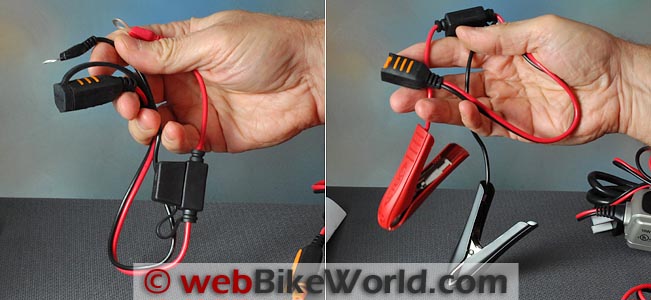
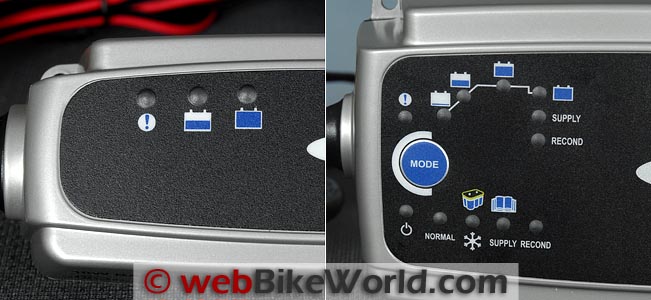
Simpler is Better?
It’s ironic that the CTEK Multi US 7002 — the “flagship” CTEK charger — actually convinced us that simpler is better.
The CTEK 7002 is a cool-looking device, no doubt about it. It has lots of bells ‘n’ whistles and an “8-step charging curve”.
It supposedly can “move far beyond the capabilities of other 12V chargers” and it can figure out “whether a battery can hold the charge given”, according to the sales brochure.
But for general motorcycle use, there actually may be too many options. Do we choose the “Normal” mode or the “Snowflake” mode? Do we want the “Supply” 13.6V mode or the “Recondition” 15.7V mode?
What does it mean when the LED lights up to indicate number 1, 2, 3 or 4?
Perhaps this is why CTEK no longer recommends the 7002 as ideal for motorcycle use. But some motorcyclists may think that spending more will buy a better charger, so we included it in this comparison. Also, it may be a good choice if you also want to charge car, RV or other types of batteries.
The CTEK 800 is a much simpler device. It has two basic functions: it charges a motorcycle battery and keeps it charged.
With a list price of $49.99, it’s much less expensive than the CTEK 7002, with a list price of $149.99 .
If you want to spend the extra money, go for it. But for general purpose motorcycle battery charging and maintenance charging for lead/acid batteries, the CTEK 800 should do just fine.
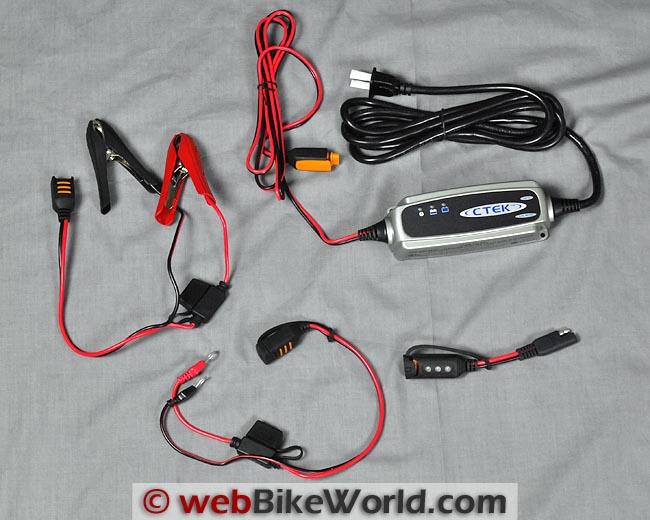
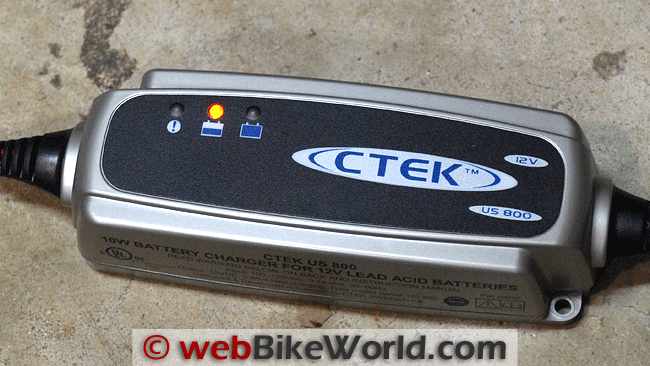
The CTEK US 800 Battery Charger
The CTEK 800 12V charger is the company’s entry-level charger. It is rated for lead-acid, AGM and “most” gel batteries up to 100Ah (not sure what they mean by “most”).
Since most motorcycle batteries run somewhere between 9Ah (the flaky Bikemaster battery that came with the Suzuki DR650) to around 30Ah (for a “high-output” type), you should be just fine with the CTEK 800.
(Note also that there is also a CTEK UC 800 charger, designed for 6V use only).
The simplicity of the CTEK 800 is its strength. Each CTEK charger (including both the 800 and 7002) comes with a nice set of alligator clips and a fused battery harness.
Unfortunately, they use a dual-pin connector system, which works well but will need an adaptor to fit the SAE connector that has become more or less standard for motorcycle use (thanks to Battery Tender).
CTEK makes an interesting adapter called the 56-564 Comfort Indicator Pigtail, which will be described in the next section.
The CTEK 800 has three LED lights: a “!” light, a light indicating that the battery is charging (the icon is a half-full battery) and a light indicating the battery is charged and the maintenance charge routine is in operation (an icon of a full battery).
If the polarity is reversed by accident, the “!” light will glow red, indicating a fault but the system protects itself against burnout.
The CTEK 800 is easy to use, with no knobs, buttons or dials. When it’s connected to a battery that needs a charge, it automatically starts a charging cycle.
We connected a digital volt meter to the battery with the CTEK 800 connected to see what happens.
The four steps or modes used by the CTEK 800 during a battery charging cycle are:
- Desulphate: Sends higher-voltage pulses to the battery if needed;
- Bulk: A constant charge given to the battery until the voltage rises to the set level;
- Absorption: Completes the charge;
- Pulse Maintenance: Monitors the battery and sends charge pulses to keep it between 95% and 100% charge.
The CTEK 800 makes a clicking sound as the pulses go to the battery during the first phase. Otherwise, it’s set and forget. As long as you eventually get a green light, you’re good to go.
The CTEK 800 is rated for use in temperatures ranging from -4F to +122F. It’s rated for use on batteries ranging from 2Ah to 32Ah, or up to 100Ah for maintenance charging.
It measures 5.5 by 2 by 1.5 inches and weighs a claimed 0.7 lbs. CTEK says the 800 is “raintight”.
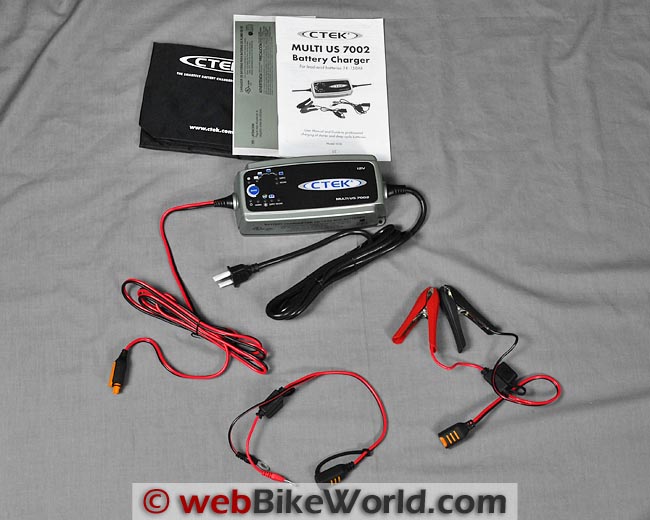
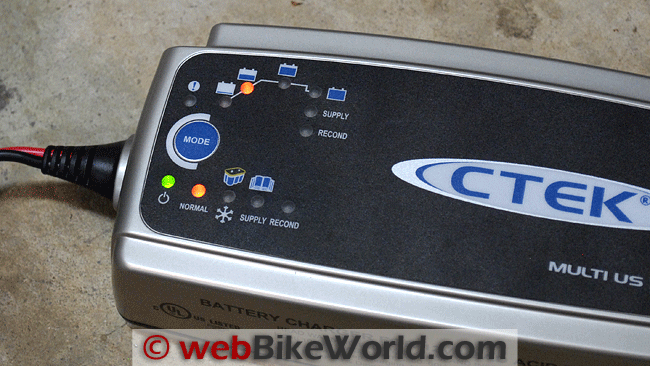
CTEK US 7002 Battery Charger
The CTEK 7002 is the company’s high-end, 8-step battery charger. It’s about twice the size of the CTEK 800 and it has a list price of $149.99.
Other than the size and price difference, the 7002 has an 8-step charging process, compared to four steps with the 800. Will you notice the difference? Probably not. The 7002 also has a membrane button for the user to switch between modes.
Four of the steps or modes in the CTEK 7002 are the same as those found in the CTEK 800.
These include Desulphate, which sends higher-voltage pulses to the battery if needed and Bulk, which is a constant charge given to the battery until the voltage rises to the set level.
Also Absorption, which completes the charge and Pulse Maintenance, which monitors the battery and sends charge pulses to keep it between 95% and 100% charge.
The 7002 adds a “Start” mode after Desulphate, which, according to the owner’s manual, “continues until the battery’s terminal voltage has risen over a preset level”.
Basically, it monitors the Desulphate mode and if the voltage hasn’t risen to the “set level” (they don’t say what that level is), then charging is suspended.
The 7002 also includes an “Analysis” mode, which suspends charging for a short time (it doesn’t say how long) and monitors the voltage drop. If the voltage drops too quickly, charging is suspended because the battery is probably faulty.
Finally, there are two maintenance modes on the 7002: a “Float” mode, which provides 13.6 volts for 10 days and a “Supply” mode, which provides a constant 13.6 volt charge.
There are a few cautions in using this mode; for example, it will increase water loss. The charger can be used as a constant 13.6V, 7A power source in this mode.
Since LFP batteries can not be used with “pulse” chargers, the Supply mode may be useful for that battery type. We send an email to CTEK inquiring about this but have yet to receive a response.
We couldn’t find any information on the CTEK website regarding the use of their chargers with LFP batteries.
The CTEK 7002 is also rated for use in temperatures ranging from -4F to +122F. Rated battery capacity is 14Ah to 150Ah; note that some motorcycle, ATV or lawnmower batteries are rated at less than 14Ah, so the CTEK 7002 may not be indicated for use with those types of batteries.
It measures 8.5″ by 3.5″ by 1.875″ and weighs 1.7 lbs. (claimed) and it’s also “raintight”, according to CTEK.
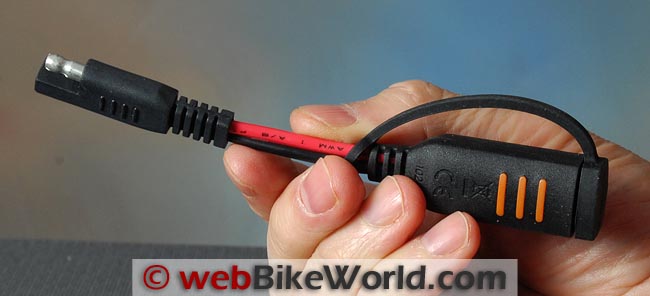
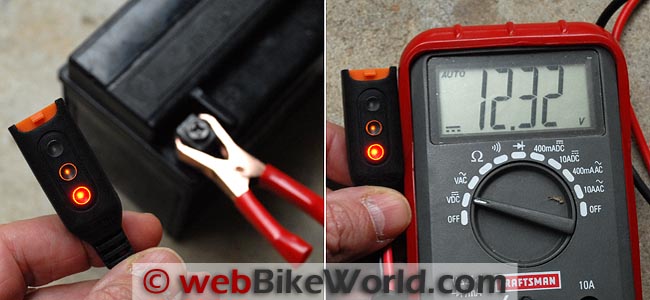
CTEK 56-564 Comfort Indicator Pigtail
The CTEK 56-564 Comfort Indicator Pigtail (List: $9.99) is an interesting device. It acts as a converter between the dual-pin CTEK connector and an SAE type connector. Plug the SAE end into your existing SAE connector and you can plug a CTEK charger to your bike.
The Comfort Indicator is so named because it has three LED lights built in: red, yellow and green. Red means the battery needs a charge; yellow means a charge is recommended and green means the battery is in good condition.
If you use a battery maintenance charger, the lights are probably unnecessary. The Comfort Indicator is also available as a panel device that can be installed flush on a dashboard. It’s also available with alligator clips.
Conclusion
The CTEK US 800 is a simple and easy-to-use motorcycle battery charger and battery charge maintenance charger that should provide good service for general motorcycle use.
In our experience, the regular use of a maintenance charger can greatly extend the life of a motorcycle battery and a properly maintained battery also gives peace of mind to the rider.
The low price of the CTEK 800, combined with the CTEK five-year warranty, makes it an excellent bargain. CTEK needs to get on board with the program; LFP batteries are the future and if the CTEK chargers are to be called “smart”, they should be able to recognize that battery type.
wBW Motorcycle Battery & Charger Reviews | Maintenance & Repair Articles
|
wBW Product Review: CTEK Battery Chargers
|
|
|---|---|
| Manufacturer: CTEK | List Price: $49.99-$149.99 |
| Color: Silver/black. | Made In: China |
| Review Date: September 2011 | |
Owner Comments and Feedback
See details on submitting comments.
From “G.A.M.” (September 2011): “Another very interesting review. I wanted to add some information that I found very confusing when I purchased a “charger/tender/maintainer” earlier this summer.
I had a motorcycle battery that I had replaced the year before, then came to suspect was still usable. I wanted to use it as a backup motorcycle battery as well as for power on a small boat to run a stereo.
I purchased a BatteryMINDer [sic] at Northern Tools, and read on the packaging that it was a charger, tender and reconditioner. I took it home and connected it to charge the battery that had been out of use for a year.
The starting voltage for the charge was about 11.2 volts on the old battery. It did not recharge the battery.
I allowed two days, but the red “charging” light never went out. I checked the voltage, and it was still where it had started out.
I then contacted BatteryMINDer support to ask what was up. They said that the product was really intended to maintain already charged batteries, and that it could not “recharge” a battery if the starting voltage was under 11.5 or so.
Huh? But your package and instructions say “battery CHARGER”, not “battery topper-upper”. I was very dissatisfied with my conversation with the manufacturer, as their packaging clearly referred to the unit a “CHARGER/tender”.
I’m not sure that the BatteryMINDer is any different from the other similar products on the market, so I am not picking on BatteryMINDef per se. I am sending this at a heads up to others who might think, unreasonably, that a battery “charger” should be able to charge a dead battery.
I hooked jumper cables to my old MC battery, and in half an hour, my car had charged the battery. But I felt the term “battery charger” was misleading. The BatteryMINDer has been minding the battery ever since, and that job it performs properly.”
Editor’s Note: I thought about this as I was editing the article and checked to make certain that the CTEK chargers are indeed “chargers”, and they are. We were able to bring two motorcycle batteries from around 11.2V to full charge.
From “F.M.” (September 2011): “I’m an electrical engineer in an aerospace firm and I have a good bit of experience with electrical power subsystems.
I and can tell you, without a doubt, that the various “modes” provided by high-end chargers will maximize the life of the battery — and minimize its capacity loss during that lifetime.
While a Deltran Battery Tender, or any “float” charger can keep a battery topped off, what is the amp-hour capacity of that originally-20AH battery after four or five years?
By the way, I just sold my Deltran Battery Tender along with a bike I sold.
That leaves me with several Yuasa SmartShot 900mA chargers, a Yuasa SmartShot 1.5A 5-stage charger, a CTEK 3300US, three PulseTech Xtreme Charge (review) chargers, a marine-grade Guest 10A multi-stage charger, a Guest trickle charger, and a built-in 1.5A boat battery maintainer.
(I currently have a boat, an SUV, three cars, four motorcycles, and a scooter, having sold three vehicles this year, explaining why I have so many chargers).
Best charger/maintainer for cheap: The Yuasa SmartShot 900. It will charge a low battery faster than a 1.25A Battery Tender and will maintain it better. Are you surprised that Yuasa knows how to make a top-notch battery charger/maintainer?
If I could only have one charger: PulseTech Xtreme Charge (the motorcycle, car, lawn and garden, marine — all the same with different color cases, so buy whatever one is cheapest or best complements your garage decor).
From “J.L.W.” (September 2011): “I too have a Battery Tender that has been going pretty much non-stop for the past 10 or 11 years.
I have a Honda Transalp with a Westco battery that’s been in there for so long that I can’t remember when I bought it and I just replaced the OEM battery on my Harley after 4 years because I just didn’t want to push it any longer and I was taking a 2-week trip.
So, bottom line, while I appreciate your reviews of different battery chargers, the Battery Tender is what works for me. BTW, I can’t tell you how many times I knocked it off the shelf onto the concrete garage floor.”


